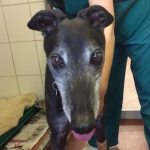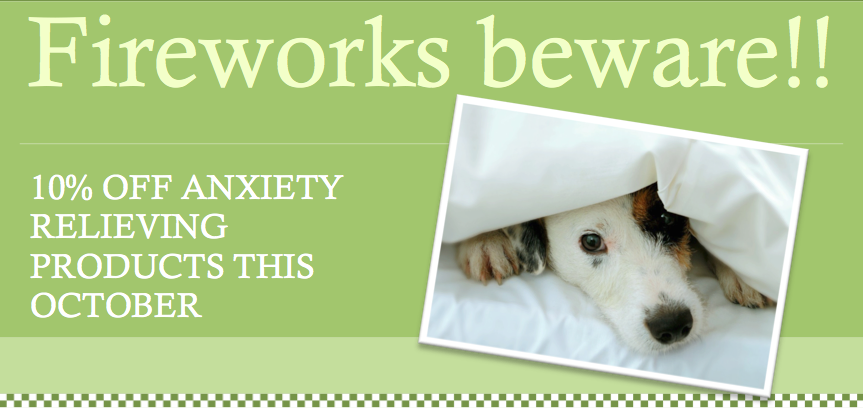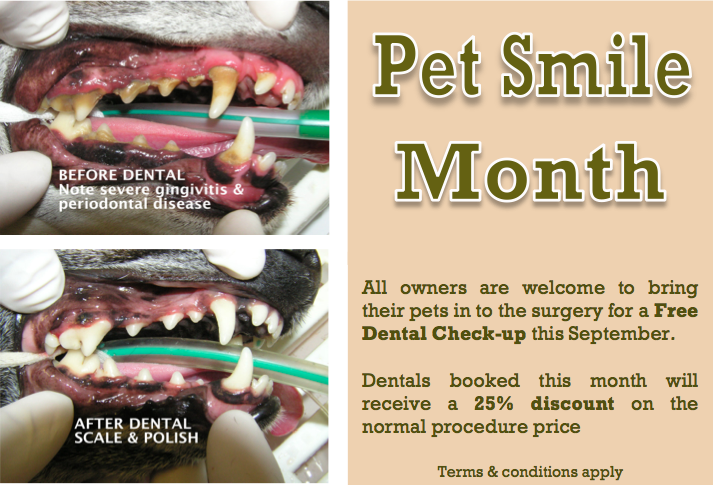News
Archive for September, 2014
Oct 14 Anxiety Relieving Products
by on September 30th, 2014
Category: Special Offers, Tags:
Pet of the Month October 2014
by on September 30th, 2014
Category: Pet of the Month, Tags:
 Bill has had a rotten time recently, having suffered from a severe bout of haemorrhagic gastro-enteritis which necessitated hospitalisation as well as intravenous fluids, intravenous antibiotics and even a plasma transfusion.
Bill has had a rotten time recently, having suffered from a severe bout of haemorrhagic gastro-enteritis which necessitated hospitalisation as well as intravenous fluids, intravenous antibiotics and even a plasma transfusion.
Bill was been a fantastic and good-natured patient throughout and we are delighted to report that he is making firm progress at last!
Fireworks – How can you help?
by on September 30th, 2014
Category: News, Tags:
Firework stress affects almost 50% of dogs and many cats too.
 With November fast approaching now is the time to take appropriate steps to alleviate a potentially distressing time for your pet.
With November fast approaching now is the time to take appropriate steps to alleviate a potentially distressing time for your pet.
Short Term Management
Long Term Management
How do anxiety-relieving products help?
Pet Smile Month Month
by on September 1st, 2014
Category: Special Offers, Tags:
Pet of the Month September 2014
by on September 1st, 2014
Category: Pet of the Month, Tags:
 When Dot failed to recover from suspected cystitis causing her to suffer difficulty in urinating further investigations were instigated.
When Dot failed to recover from suspected cystitis causing her to suffer difficulty in urinating further investigations were instigated.
Ultrasound images of her bladder revealed a large bladder stone and analysis of her urine led us to believe this was composed of a substance called struvite. As her symptoms were not so severe as to require surgical removal of the stone she was put on a diet aimed at dissolving the stone.
The remarkable effect that dietary change can have on certain bladder stones was clearly seen in the before and after ultrasound images we took. Six months after diagnosis her bladder was totally empty!
Streptococcal Pneumonia in Dogs
by on September 1st, 2014
Category: News, Tags:
An Emerging Respiratory Disease That Can Kill
The Canine Infectious Respiratory Disease (CIRD) Group at the Royal Veterinary College (RVC) are currently researching a bacterial disease that has been increasingly implicated in fatal cases of infectious pneumonia in dogs over the past five years. They are calling for dog owners and vets to recognise the signs of the potentially fatal disease Streptococcal pneumonia to ensure rapid treatment and contribute to research to reduce further spread.
The bacterial infection Streptococcus zooepidemicus causes a severe, bloody pneumonia in dogs, producing signs similar to those associated with toxic-shock syndrome in humans.
How is Streptococcus zooepidemicus transmitted?
The bacterium can be ‘carried’ by dogs in their upper respiratory tract (most likely their tonsils) without showing any symptoms of disease and it is likely that, as yet unknown, bacterial, host or environmental factors, possibly including an over-exuberant immune response to the bacteria, are responsible for the severe pneumonia observed in the worst cases. These ‘carrier’ dogs may be an important source of infection if introduced to new populations, especially in rehoming kennels where dog come and go all the time.
What are the signs of Streptococcal pneumonia in dogs?
Infected dogs develop the following signs:
Sudden-onset fever
Sneezing
Rapid, shallow breathing
Bloody discharges from the nose or mouth
Lethargy (tiredness)
Reluctance to eat
Some dogs may collapse, which indicates a developing septicaemia. In most cases this occurs within 12-24 hours of the onset of the first symptoms (which may be mistaken for classical ‘kennel cough’ caused by viruses). In a small proportion of cases, the disease has been known to be fatal to dogs within 24 hours of contracting the infection.
How likely is the disease to occur in pet dogs?
In most cases there seems to be a trigger-factor such as a significant stressful event, for example rehoming, strenuous activity such as a race, or preceding illness. Outbreaks are isolated and tend to occur where dogs mix in large groups. Although it is rarer in family pets, it is still important for owners to be aware of the symptoms, especially if they regularly visit kennels or go to events where animals gather. In the initial stages, signs are similar to those of the more common ‘kennel cough’, which occurs in similar environments. However, in Streptococcus zooepidemicus outbreaks, dogs quickly become seriously ill and show very severe signs. In contrast, most dogs with kennel cough will usually have a relatively mild illness and deaths are rare.
Can pneumonia caused by Streptococcus zooepidemicus be treated?
Treatment of Streptococcal pneumonia is often ineffective unless started rapidly following onset of the first symptoms and is currently based on a suspected diagnosis. If owners notice the sudden onset of a fever in their dog, accompanied by sneezing, nasal discharge which is often bloody, and their animal becoming lethargic, they are advised to seek veterinary help immediately. With prompt identification, medical treatment and supportive care, dogs can make a full recovery.



